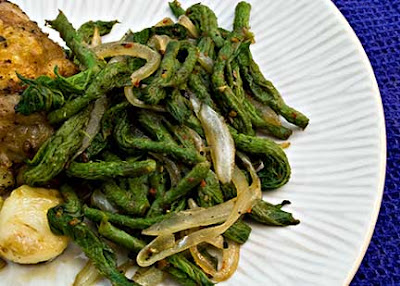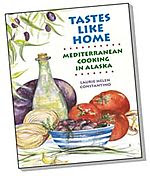I hit the Taste and Create mother lode this month.
Taste and Create is an event organized by For the Love of Food. In this event, food writers are paired with a randomly assigned partner, and asked to cook and review one recipe from their partner’s blog.
Taking part in Taste and Create can be a challenge. Participants come from very different backgrounds and have widely divergent interests. But the commitment you make when signing up for Taste and Create is to cook from your partner’s blog, whether or not their recipes are ones you’d otherwise make.
I like Taste and Create for the same reason I liked grab bags as a kid; you never know what you’ll get until you open the bag.
This month, Abby at Eat the Right Stuff is my Taste and Create partner. The recipes on her blog, which was new to me, are wonderful; I wanted to make them all. The ingredients and seasonings she uses are the ones I love most. Abby’s writing is easy to understand and her photographs inspirational. Like I said, I hit the mother lode.
As soon as I read the description “pork stuffed with pork wrapped with pork,” I had to make Abby’s recipe for Stuffed Pork Tenderloin. As Abby promised, the caramelized onion, chorizo, lemon, and spinach stuffing was fabulous, and the accompanying rice worth making on its own.
I did have to deal with the typical vagaries and ingredient difficulties that always exist when making a recipe created in another country. For example, the recipe calls for “2 picante (hot) chorizo sausages.” I don't know about London (where Abby lives), but in the US, chorizo comes in many sizes and forms, including fresh and dry-cured, and is imported from many different countries.
I ultimately decided the stuffing would be good with any of the multitude of available chorizos. I ended up using a dry-cured chorizo seasoned with hot smoked paprika made in Spain by Palacios (and bought at Sagaya in Anchorage). For those who don’t have access to chorizo, hot Italian sausage would be a good substitute.
Spicy chorizo, earthy spinach, and bright-flavored lemon combine to make a delicious stuffing for mild-flavored pork tenderloin. The pork is finished with a crispy pancetta wrapping and served on a bed of surprisingly good Chorizo and Spinach Pilaf.
 Photograph by Abby at Eat the Right Stuff
Photograph by Abby at Eat the Right Stuff
Stuffed Pork Tenderloin with Chorizo, Spinach, Lemon, and Pancetta & Chorizo and Spinach Pilaf
Serves 4 - 6
Adapted from Eat the Right Stuff
If you can’t find chorizo, substitute your favorite salami or fresh hot Italian sausage.
1 pork tenderloin (1 – 1 1/4 pounds)
1 8-ounce dry-cured hot chorizo sausage
1 1/2 cups diced yellow onion, 1/4” dice
1 Tbsp. olive oil
Salt
Freshly ground black pepper
9 ounces cleaned and roughly chopped spinach, divided
3/4 cup Panko breadcrumbs
2 tsp. finely grated lemon peel
2 Tbsp. lemon juice
16 slices of pancetta (see NOTE)
1 cup long-grain rice
2 cups chicken stock
Preat the oven to 400°F.
Wash the pork and dry it well. Cut the pork in half, lengthwise. Place the pork between two sheets of plastic wrap and pound it with a meat pounder (or rolling pin) to flatten it slightly.
Remove the casing from the chorizo and cut the meat into 1/4” dice.
Sauté the onion, lightly seasoned with salt and freshly ground black pepper, in olive oil until it softens and starts to turn golden. Add the diced chorizo and cook until the onions begin to caramelize. Remove half the onions and chorizo and most of the oil to a bowl and reserve it for making the pilaf.
Add half the spinach to the pan and cook, stirring regularly, until it wilts. Remove from the heat and stir in the breadcrumbs, lemon peel, and lemon juice. Season well with black pepper. Taste and add salt or freshly ground black pepper, as needed.
Line up the slices of pancetta so they are slightly overlapping to form a pancetta rectangle. Top with half the pork tenderloin, then the stuffing, and then the remaining tenderloin. Wrap the pancetta around the tenderoin to fully encase it. Put the roll in a roasting pan, with the pancetta seam side down. Bake for 25-30 minutes or until the pork is cooked through. Remove from the oven and let rest for 5-10 minutes before slicing and serving.
While the tenderloin is roasting, make the pilaf: Put the reserved onion, chorizo, and oil in a pan and heat. When it starts sizzling, add the rice and stir well to coat the grains with oil. Cook for 1 minute, then stir in the stock and bring it to a boil. Cover, turn down the heat to low, and let the rice cook for 20 minutes. When the rice is done, stir in the remaining half of the spinach.
Serve slices of Stuffed Pork Tenderloin with Chorizo, Spinach, Lemon, and Pancetta over a bed of Spinach and Chorizo Pilaf.
NOTE: The pancetta slices must be long enough to wrap all the way around the stuffed tenderloin; this size of pancetta is available only from deli counters and specialty stores in most of the US. Too often, the only readily available pancetta is sold in pre-sliced 3-ounce vacuum-packed plastic bags. These pieces of pancetta aren’t long enough to wrap the tenderloin; if this is the only kind available, buy two 3-ounce bags to make sure there is enough pancetta.
 It’s been seven months since I started writing regularly for Mediterranean Cooking in Alaska. From fall’s end, through a
It’s been seven months since I started writing regularly for Mediterranean Cooking in Alaska. From fall’s end, through a  Bob the Bird-Watcher
Bob the Bird-Watcher I wrote about the unique flavor of devil’s club, a wild plant growing primarily on the Pacific coast of the United States from Alaska to California, in this post:
I wrote about the unique flavor of devil’s club, a wild plant growing primarily on the Pacific coast of the United States from Alaska to California, in this post: 



 After the Fire: Destruction Bay, Yukon Territories, Canada
After the Fire: Destruction Bay, Yukon Territories, Canada

 White-washed houses, bright blue skies, sun sparkling on the sea, and brilliant sunsets. Some of Greece’s most iconic images are of
White-washed houses, bright blue skies, sun sparkling on the sea, and brilliant sunsets. Some of Greece’s most iconic images are of  Shrimp Santorini in Tomato and Caper Sauce (Γαρίδες Σαντορίνης)
Shrimp Santorini in Tomato and Caper Sauce (Γαρίδες Σαντορίνης)






 Palek Paneer (Spiced Spinach and Cheese)
Palek Paneer (Spiced Spinach and Cheese)















































